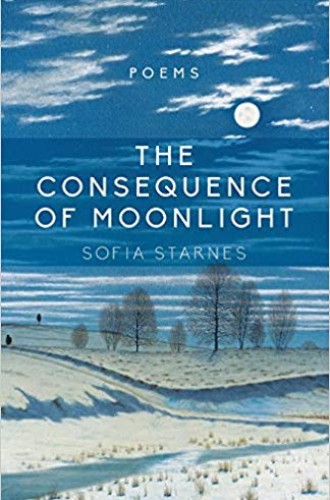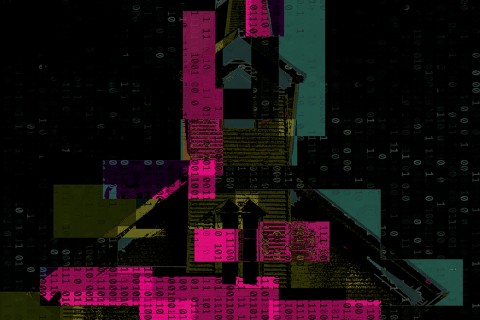Sofia Starnes writes in her title poem: “The consequence of moonlight / is a sigh, and saints out in the garden, strong / and pure, lift stories, as if bodies, // to the sky.” These lines express the gist of the whole volume, the interweaving of saints and stories as bodies (both heavenly and earthly) reflect a greater light.
In her note to readers, Starnes explains her poetic mode. Her metaphorical way of thinking aims to link readers to the call of the infinite, since metaphor is the best response finite beings can make to that for which there is no correspondence. This linking is vital, Starnes believes, for a poet of the sacred—and essential to that work is the poet’s own self-emptying, a sort of kenosis. She writes:
The act of writing poetry is, for me, an emptying of self—a getting out of the way. In the poet’s stead is the poem, which becomes a place of resonance, where the reader might recognize a voice otherwise unheard. For this to occur the poet must be autobiographically silent, so that the poems, individually and as a whole, transform into depositories for the reader’s experience.
She then explains the overall composition of the collection. The recurring character of Elena is etymologically connected to the moon and is a key to the volume’s lunar consequences. Elena herself is emptied out in the middle section, Starnes writes, as a prerequisite to the character’s reemergence in the holy light of the final section, where we endeavor to walk with the saints.
The book’s title, Starnes explains, “points to how the moon functions: she has no light of her own but lives on borrowed light, as we do.” In her many evocations of the moon, the poet emphasizes lunar darkness, absence, and fulfillment. The moon is the ever changing but always returning line between the immutable and mutable worlds. “She is all this, perhaps, because she must be here and there, orbiting the earth but not of the earth,” Starnes explains. “Through her inherent paradox, the moon underscores a quality we rarely mention in our daily lives, but which the poems attempt to express as well: the quality of sainthood. Saints always meet the dark with light, yet their luminosity is often seen as lunacy in the world.”
As this explanation reveals, the book has high aims. But its pleasures are immediate, for the poet’s use of language contains within it the mysteries of the volume itself. For Starnes, poetic language is the language of faith; hence the use of biblical quotes at the end of many of the poems.
The poems are mysterious, lunar, and feminine in mystique. Like Emily Dickinson, Starnes tells the truth slant. Like Gerard Manley Hopkins, she reveals the sacred through linguistic inscape. Starnes can be oblique, but often the obliquity is so seamlessly a part of a poem that to ask for something more direct would be to alter the meaning entirely. Her words are the indirection of the body itself, whose evidence can never be discursive.
These are sensual poems; many of them are love poems. Throughout the volume, the mystic’s sensual love of life emerges alongside the belief that the deepest knowledge is in the kind of unknowing that only the senses can reveal. In “Unknowing,” the poet concludes:
We might forget the hammock in the yard,
or how to lie reliant,
how low the branches, how profuse the air
with bright red apples dangling.But if they fall, we shall remember thud,
and with each peel, the aftermath of leave.
Touch me, my love. For knowing reconvenes
as constancy.We had a birth, a life of fingertips.
How do we know?
How, but through trembling.
Starnes’s poetry takes us on sacred roads, much like pilgrims. Even in a poem titled “Chaos Theory,” we feel the sacred impulse beating fast.
In “Catacomb,” a poem worthy of Rainer Maria Rilke’s linking of terror and beauty, Starnes writes of an old woman taken out of the rubble after an earthquake:
So she rose, dreamy, and her eyes,
unbeknownst to dove or raptor, adolesced—
Oh, a century as egg; under veil, a ribcage hatches.The place is too cramped for me,
make room for me to live.
Isaiah 49:20
This poem is parabolic, like many others in the volume, and Starnes is a master of such form. Because it affirms nothing and thus cannot lie (as Sir Philip Sidney put it), poetry is among the truest acts of translation in language’s flirtation with the betrayal of reality. Starnes’s best lines remind us of this unaffirmed truth. In “Baptism of Desire,” she writes: “Apocalyptic is too long a sigh, / the evening light translates to evening wind.” And in “Tunnelers,”
The geese have come with glaciers
on their feet,
grey wings and winter eyes,
artful in early sun and cold debris.
In sharp contrast to the religious yearning for eschatological significance, for the roots in the afterlife (as she writes of in her last poem, “Love and the Afterlife”), the pressure of Starnes’s poems is felt most in the simple tenderness of the word as it is being made flesh, and as flesh’s wounds are being healed.






